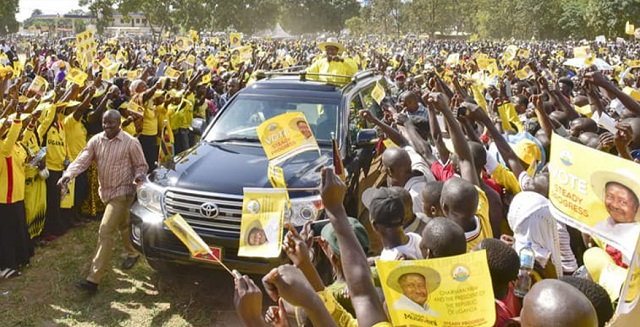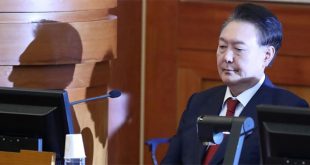
Changing role of colour
Uganda’s political parties have traditionally had official colours. According to the Electoral Commission, Uganda has 29 registered political parties and each has unique symbols and colours to ease voter recognition during elections and create harmonious party co-existence.
Colours have meant almost nothing in everyday life as many FDC die-hards routinely wear yellow and many NRM stalwarts easily wear red. But that is changing.
Many people, especially at public functions, are emulating the late NRM legislator, Col. Ibrahim Abiriga (then-MP for Arua Municipality) who became the best example of how politicians use party colours to show allegiance.
Abiriga was unapologetic about the colour yellow. He was a self-proclaimed diehard supporter of President Museveni and the NRM. He even got the moniker “yellow man.”
Abiriga confessed to The Independent in 2017 that his wardrobe is predominantly yellow; his suits, shirts, shoes, hats, socks and even undergarments.
“Everything on me has to at least have yellow if it is not fully yellow,” he said, “The plate I use, the cups, my bed is yellow, house and everything must be yellow.”
Abiriga who was two years into his first term as a Member of Parliament for Arua Municipality in northwestern Uganda died in a hail of bullets on June 8, last year, as he was returning to his home in Kawanda. The election to replace him was the most violent.
The trend of associating politics with colour of dress is growing, sometimes with negative outcomes if not violence. A retired diplomat who teaches at Uganda Martyrs University in Kampala recently rudely found out how things can go if one wears the ‘wrong’ colour.
The diplomat who requested not to be named said as he was reporting to work on the weekend of Aug.24, he realised that one of his car tyres was getting flat and branched to a garage in the Rubaga area in the western division of Kampala city to get it fixed.
However, there was a small problem.
He was caught unawares as the garage attendants he expected to fix his car, remained glued to their seats. Instead the young men sneered at the old man rudely. He read the non-verbal cue and drove away. He was wearing a cream shirt that the youthful mechanics probably considered too “yellow.”
Political analysts have told The Independent that the 2021 general election will probably be one of the most colourful elections Uganda has ever held with yellow and red being the most dominant colours.
Dr. Patrick Wakida, the executive director of the Kampala-based polling firm Research World International told The Independent recently that there is a sign of growing opposition to NRM.
“That is why if you see people being stopped from wearing certain colours, you should know that the pressure on the ruling government is growing,” Wakida said, “When they see people wearing red gathering in large numbers, they perceive that as a threat to the ruling party.
Wakida said people join political parties out of conviction, fear, or because they have seen the other political group gaining popularity and as such they would want to be a part of that group.
Colour has always been a delicate matter in Ugandan politics. The late Mayor of Kampala City, John Ssebana Kizito, who was a DP youth winger and later president general told The Observer in 2011 about how a minister in President Obote’s government chased away a civil servant who had turned-up wearing a green shirt at a government function. The official colour of Obote’s Uganda Peoples Congress (UPC) party is red.
“There were so many such little fights at the time,” said Ssebana. The emphasis was on “little fights.”
In 2009, at the launch of electoral reforms by the opposition in the Parliament Gardens, the Electoral Commission Chairperson Badru Kiggundu was put on the spot when Dr. Kizza Besigye remarked that all guests had turned up in “their colours” including Kiggundu. The EC boss whom the opposition often accused of favouring NRM was decked in a yellow tie.
Mwambutsya Ndebesa, a political historian based at Makerere University says the use of colour in competitive politics is an important tool for political parties to portray their ideals and connotations. But in Uganda colours play a crucial practical role.
“Considering that the majority of the population is still peasantry with low levels of education, you don’t expect Ugandans to identify parties based on programmes or ideology,” Ndebesa told local broadcaster, NTVU, early this year, “In the absence of political ideology and programmes, what simplifies and creates meaning for political parties are colours.”
Aritua who did the study predicting violence says politicians need to tell their supporters that colours are mere means to differentiate one party from another.
“It is important that politicians take charge and inform their followers about the need to co-exist.”
Theodore Ssekikubo (MP Lwemiyaga, NRM) told The Independent on Aug.31 that nailing the young man is wrong and shows growing extremism and criminality around the country.
“It is not that people are tired of the colour yellow; it is just the growing level of intolerance in the country. Yellow is an embodiment of a particular political group in this country and this boy happened to be wearing this colour perceived to belong to this political group.”
“Whether NRM was using red, black or blue, it would not have made any difference. It is the intolerance and criminality that is being used in the name of politics. This must be fought by all political leaders in the country.”
“Tolerance is a cardinal principle in a democratic society,” said opposition MP and People Power firebrand Muhammad Muwanga Kivumbi (MP Butambala, DP) “I may not like yellow but I cannot hold it against a person. Society shouldn’t be pushed to the level of intolerance because it can breed war.”
“Leaders must ensure that at all times, tolerance is exercised. So many people are victims of circumstances; some of them support an oppressive regime because they need to survive,” he told The Independent.
****
 The Independent Uganda: You get the Truth we Pay the Price
The Independent Uganda: You get the Truth we Pay the Price



